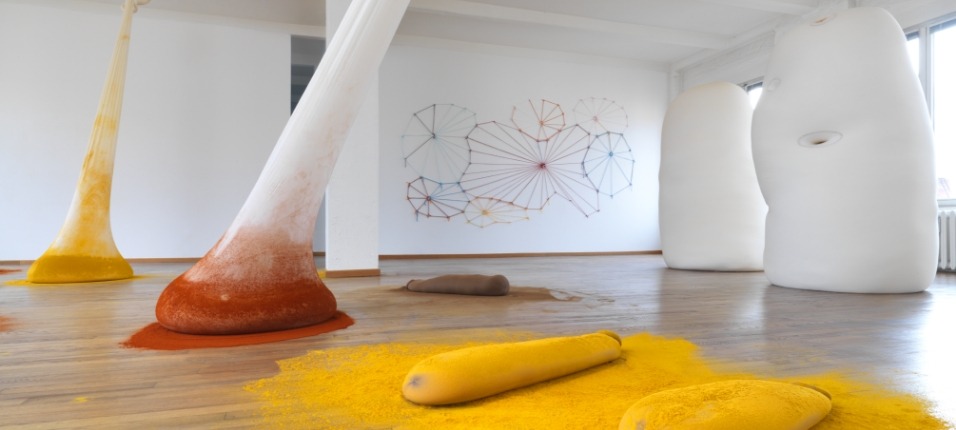Hoffmann Collection: a life with art

Berlin is losing an exciting collection of contemporary art. For 25 years it was open to the public in the Sophie-Gips-Höfe in the immediate vicinity of the Hackesche Höfe. This year, there will be one last opportunity to see the current "furnishings."
Erika Hoffmann, now 83, objects to the term "collector." Although she and her late husband have compiled some 1,200 works over the decades, she does not consider herself a collector in the classic sense. Art is a passion and has become her purpose in life.
While the Hoffmanns together led the "Van Laack" clothing brand to success, they began to acquire and also show works of art as early as the 1960s. Today, the collection includes works by Marina Abramović, Keith Haring, Gerhard Richter and Andy Warhol.
Top: Installation with works by Ernest Neto, photo: Jens Ziehe.
Left: Erika Hoffmann in front of "Atlas of wall 81 extraits 'Manifesta' #10 by Joelle Tuerlinckx,tables and chairs by Warren Platner, Photo: Alexander Gehring

Curiosity for discoveries
Although the Hoffmann couple had to plan strategically and act commercially in their business, it was to be quite different with art. The Hoffmanns did not want to pursue any strategy, but rather to make discoveries. Regardless of an artist's name recognition or market value, they bought art that was new and surprising. They were also happy to buy art that they did not immediately understand. They were curious about new impressions, about the unexpected, art in the making. Elke Giffeler, the head of the collection, compares the acquisitions to diary entries that reflect the life situation, interests, encounters and discussions between the couple. In this way, a very personal and heterogeneous collection was created.
To Berlin
After selling their business, the Hoffmanns devoted themselves entirely to art. In the 1990s, they won over other private collectors to the project of an art gallery for contemporary art in Dresden and initiated a bold design by the artist Frank Stella for a building near the Zwinger.
Following the failure of the project, the Hoffmanns decided on Berlin as the center of their lives and the location of their collection. They acquired the dilapidated Sophie-Gips-Höfe and turned them into what they are today: a lively mix of commerce, living and gastronomy. In the premises of a former sewing machine factory, the Hoffmanns created spacious rooms on two floors where they could live with parts of their collection and receive visitors.
Right: Works by Rosa Barba, Ettore Spalletti, Isa Genzken and Roni Horn, Photo: studioschuurman

Changing "furnishings"
For the past 25 years, a new selection called "Einrichtung" (furnishing) has been put together once a year. Based on a motto, artists and works were selected, rediscovered and rearranged again and again. On Saturdays, these facilities were also open to the public. Between 100 and 120 visitors took part in the tours week after week, 130,000 people in 25 years. About 40 percent of the visitors were Berliners who came again and again to see each new furnishing. In addition to the Berliners, a relatively large number of Scandinavians came, reports Ms. Giffeler – for whatever reason. The current furnishing is expected to remain on display until the end of 2022. It will be the last one. The motto: Dance the dance. Included are works by Lucio Fontana, Isa Genzken, Katharina Grosse, Sigmar Polke and Andy Warhol.
Left: East facade of the Sophie-Gips-Höfe with word sculpture by Lawrence Weiner, in front of it a lawn sculpture by Teresa Murak.

The collection leaves
An era comes to an end. Erika Hoffmann is parting with her artworks. In 2018, she donated the collection to the city of Dresden and it will move there within a transitional period of five years. It was important to Mrs. Hoffmann that it should remain together and that works by unknown artists also should be secured and scientifically supervised. In Dresden, the Hoffmanns' objects will not be given a place of their own, but will "meander," as Giffeler puts it, through the existing museums, entering into a dialogue with other exhibits. These don't necessarily have to be works of art. At the moment, for example, a poem by artist Marcel Broodthaers on the subject of money is on display in the coin cabinet.
Right: Works by François Morellet and Katarzyna Kobro, Photo: Jens Ziehe

When asked whether the collection could have stayed in Berlin, Giffeler points to the couple's long-standing ties to the city of Dresden. But that may not be the only reason. Although Mrs. Hoffmann had dealings with the heads of all the institutions in the Berlin art world and everyone could see that she was getting older, no one in Berlin ever showed any interest in what was going to happen to the collection, as Mrs. Giffeler recalls.
